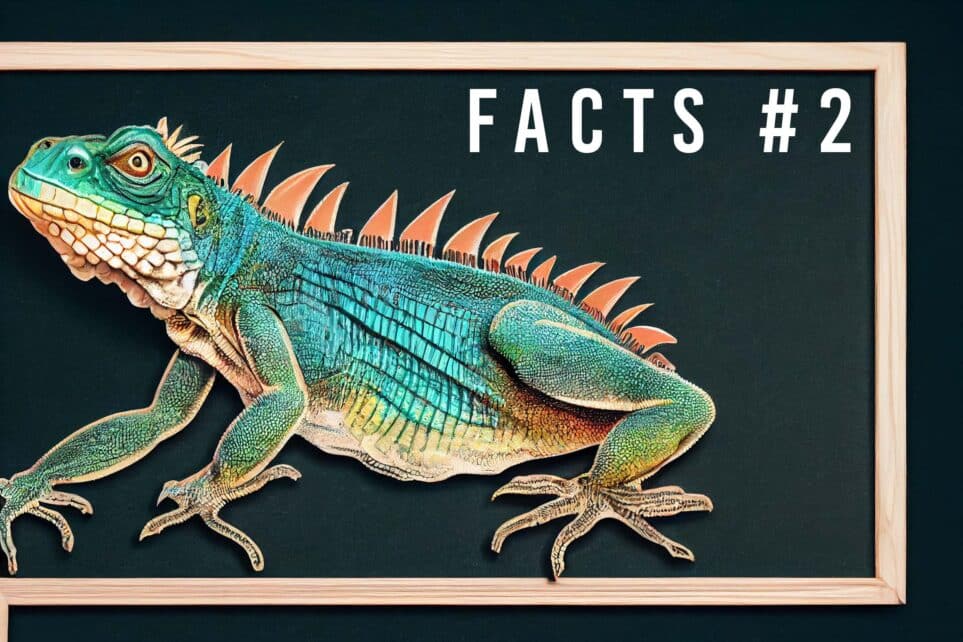Interesting Facts About Iguanas
Iguanas originate from the tropical parts of South America, Caribbean islands, and Central America. Most people don’t realize that the large population of green iguana in Florida are not native to that state but rather were brought in as pets or inadvertent stowed away on ships. They have been thriving in the warm climate of Florida ever since the 1960s. Still, over the past few decades, their numbers have grown exponentially to become quite a nuisance.
While many people keep iguanas as pets, they can cause considerable damage to properties and homes. In addition, the diet of the green iguana has wreaked havoc on the natural environment around Florida. If you are from South Florida, chances are you have seen several of these tropical creatures near your home. If you are looking for more information on green iguanas, here are eight interesting facts about them and what to do if they overrun your property.
1. They Need a Warm Habitat
Iguanas hate the cold. They need very high temperatures to survive. Just look at where they originate (South America, Central America, and the Caribbean islands) and how much they have in common with South Florida, where they have been flourishing for decades. All these places are sunny all year round and can get very hot. In northern and central Florida, the iguana population is not that large because it doesn’t get hot enough there. The Keys and Miami area’s weather is perfect for iguanas as they need direct sunlight to survive. That is why they can often be seen basking out in the hot midday sun when other creatures prefer the shade.
2. They Can Swim
As part of the reptile family, they are excellent swimmers and can swim in fresh and salt water. They can hold their breath underwater for up to fifteen minutes in the right temperatures.
3. They Have a Long Life Span
On average, iguanas can live up to 9 years in the wild. However, if cared for properly, they can live much longer in captivity. Some iguanas kept in captivity have lived up to 20 years.
In addition to a long lifespan, iguanas can develop very long bodies, with male iguanas growing up to 6 feet long while females are generally smaller.
4. They Shed Their Skin and can Shed their Tails
Adult iguanas typically shed their skin once a year, while younger ones shed multiple times yearly. They rub their bodies against trees or rocks when shedding to get rid of the skin faster.
Iguanas have a survival mechanism that allows them to escape from predators. They can release their tails from their bodies when threatened, for example, when stepped on, picked up by their tail, or when they get stuck. The tail usually breaks off cleanly at an intersection between vertebrae. If this happens when they are still young and growing, the tail will usually grow back. However, if they are too old or the tail is removed by any other means, it may never grow back.
5. Green Iguanas Have Three Eyes
Even though it is not a real eye, green iguanas have a third eye situated on the top of their heads. Although it does not function as a normal eye, this third eye does have certain anatomical characteristics of normal iguana eyes. Known as the parietal or pineal gland eye, even though it cannot see images, it can sense movement that alerts the iguana of predators that may be threatening them from above. Certain fish species and other lizards also have such a feature.
6. Iguanas can Communicate with Each Other
Iguanas generally don’t make sounds but use body language to communicate with each other. They communicate nonverbally by bobbing their heads up and down and flapping the skin below their necks, called a dewlap. While slow up-and-down head movements are usually done to greet or acknowledge each other, faster head bobbing is usually a sign of agitation and often indicates aggression. It may also be used as a territorial display.
When an iguana displays aggressive head bobbing or a whipping tail, it is usually a sign that something has upset it and could be dangerous to approach.
Extending the dewlap could be interpreted as a sign of greeting. However, males also flap their dewlaps when courting.
7. They Can Fall Out of Trees
In 2020 iguanas falling out of trees in South Florida made the national news. During the coldest night in decades, sub-40-degree temperatures effectively stunned the iguanas to a point where they could not function. The cold slowed their metabolism to a degree where their bodies entered a comatose-like state, loosening their grip on the tree branches, and they were found lying on the lawns, streets, and sidewalks of Florida. They were still alive and able to move again once their body temperatures rose enough to restore mobility. This can happen to iguanas anytime the temperature falls below 45 degrees.
According to experts, this may cause a problem for Florida if iguanas adapt to the cold as it could threaten the other parts of that state where iguanas are not currently multiplying that fast. Suppose the iguanas manage to adapt their bodies to tolerate lower temperatures. In that case, their populations may expand throughout the state of Florida.
8. Green Iguanas in Florida Are Not a Protected Species
Green iguanas have only introduced to the state of Florida about 60 years ago. While these fascinating creatures serve an important role in the tropical environment of their native habitat, Florida is not their original home. Iguanas frustrate property owners by destroying vegetation, landscaping, and damaging fences and walkways. They are also a threat to many species native to Florida, such as the snails and plants they feed on that are important members of the natural ecosystem.
Iguanas are generally considered to be a nuisance. Because they are not protected by law as a protected species (except for animal cruelty laws), they can be humanely killed at any time by residents on private property.
However, be advised that you are not allowed to capture iguanas and release them elsewhere. Unfortunately, they must be killed before they can be removed by wild animal control.
Suppose you are experiencing a population overgrowth of iguanas on your residential property or business premises. In that case, you can call Iguana Control to evaluate the problem in order to effectively remove an iguana infestation from your property.
Green Iguana Facts Specifically for Florida Residents
Green iguanas can make excellent pets if cared for under the right conditions. For those interested in keeping these fascinating pets, many more green iguana facts are available. However, bear in mind that iguanas are not meant to roam around in the streets of Florida, becoming a nuisance and threatening the native species indigenous to the state.
If you need assistance in getting rid of an extensive iguana population on your property, contact wildlife removal services of Florida today for a free estimate for the humane removal of iguanas from your property.

